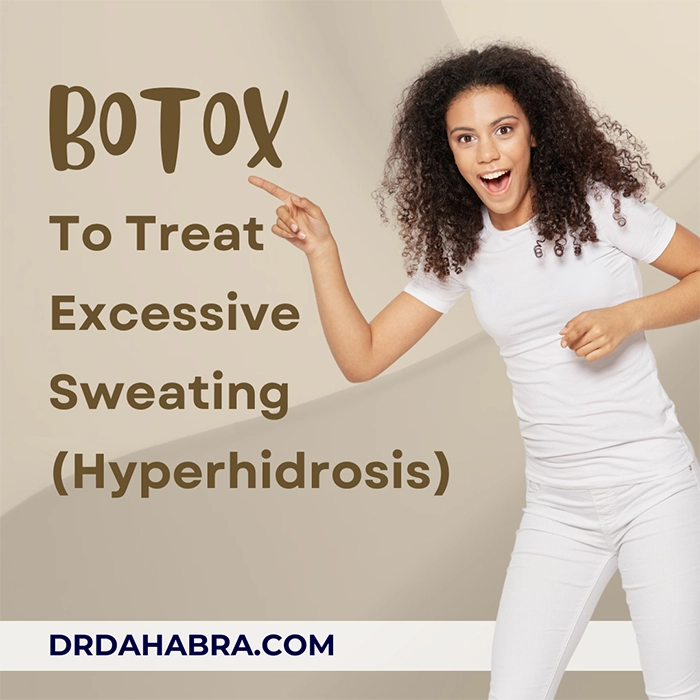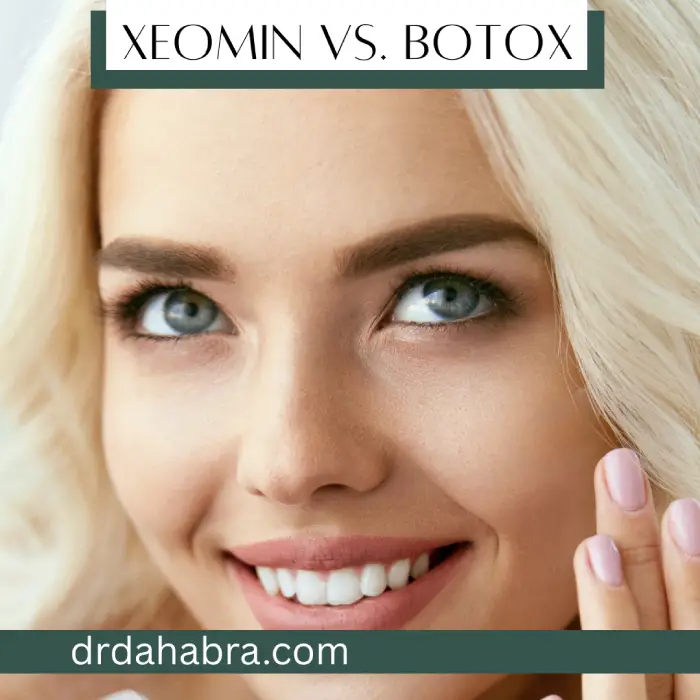The Ultimate Guide to Botox to Treat Excessive Sweating (Hyperhidrosis)
Understanding Hyperhidrosis: Causes and Impact
Hyperhidrosis, commonly referred to as excessive sweating, is a medical condition in which the body’s sweat glands become overactive, producing more sweat than necessary for regulating body temperature. This article is the ultimate guide to Botox to treat excessive sweating hyperhidrosis.
While sweating is a normal physiological process, individuals with hyperhidrosis experience persistent and uncontrollable sweating, regardless of external temperature or physical exertion.
This condition can be classified into primary focal hyperhidrosis, which typically affects areas like the underarms, palms, feet, and face, and secondary generalized hyperhidrosis, which is often linked to underlying health conditions such as diabetes, infections, or hormonal imbalances.
The exact cause of primary hyperhidrosis is not entirely understood. Still, it is believed to be related to overstimulation of the sympathetic nervous system, the part of the autonomic nervous system responsible for activating sweat glands.
In many cases, hyperhidrosis appears to run in families, suggesting a genetic component. Unlike secondary hyperhidrosis, which can develop at any age due to medical conditions or medications, primary hyperhidrosis typically begins in childhood or adolescence.
It persists into adulthood without an identifiable external cause.
The impact of hyperhidrosis extends beyond physical discomfort; it significantly affects an individual’s emotional and social well-being. Excessive sweating can lead to embarrassment, anxiety, and self-consciousness, often limiting participation in social activities or professional environments.
Many sufferers avoid shaking hands, wearing certain fabrics, or engaging in activities that could make their sweating more noticeable. If left untreated, hyperhidrosis can lead to psychological distress, making effective treatment.
Table of Contents
1. Mechanism of Botox in Treating Excessive Sweating
2. Common Treatment Areas for Botox in Hyperhidrosis
3. Detailed Botox Treatment Procedure for Hyperhidrosis
4. Pain Management Strategies During Botox Injections
5. Expected Results and Timeline Post-Botox Treatment
6. Duration of Botox’s Effectiveness in Hyperhidrosis Management
7. Potential Side Effects and Risks of Botox for Sweating
8. Botox Treatment Protocols for Palmar Hyperhidrosis
9. Essential Considerations Before Undergoing Botox Treatment
10. Cost Analysis of Botox for Hyperhidrosis Treatment
11. Frequency and Necessity of Repeat Botox Treatments
12. Evaluating the Pros and Cons of Underarm Botox
13. Age Limitations and Recommendations for Botox in Hyperhidrosis
14. Alternative Treatments for Hyperhidrosis and Their Efficacy
15. Table 1: Factors Affecting Botox for Hyperhidrosis Cost
16. Frequently Asked Questions (FAQs)
17. Table 2: Comparison of Hyperhidrosis Treatments
18. Conclusion
19. References
1. Mechanism of Botox in Treating Excessive Sweating
Botox, scientifically known as botulinum toxinA, is a neurotoxin derived from the bacterium Clostridium botulinum.
While commonly associated with wrinkle reduction, Botox is also FDA-approved for treating hyperhidrosis. It blocks nerve signals that stimulate the sweat glands, effectively reducing sweat production in targeted areas.
Unlike topical antiperspirants, which only control surface moisture, Botox addresses the root cause of excessive sweating by preventing acetylcholine, a neurotransmitter responsible for activating sweat glands, from sending signals to produce sweat.
The process involves injecting small amounts of Botox directly into the affected area, such as the underarms, palms, feet, or face. These injections temporarily paralyze the overactive nerves responsible for excessive sweating, leading to a noticeable reduction in moisture within a few days.
Clinical studies show that Botox can decrease sweating by up to 87%, with results lasting between 4 to 12 months, depending on the treatment area. Botox provides a non-invasive and localized solution with minimal downtime, unlike other hyperhidrosis treatments, such as oral medications or surgical procedures.
Despite its effectiveness, Botox for excessive sweating is not a permanent cure; repeat treatments are necessary to maintain results. Over time, some individuals may require fewer treatments as the nerves become less responsive.
While Botox is widely considered safe, the procedure must be performed by a trained and experienced medical professional to avoid complications, such as muscle weakness or unintended nerve effects. Given its success rate and minimal side effects, Botox remains one of the most trusted and widely used treatments for hyperhidrosis today.
2. Common Treatment Areas for Botox in Hyperhidrosis
- Underarms (Axillae): The underarms are the most commonly treated area with Botox for hyperhidrosis. Injections in this region have been shown to reduce sweating by approximately 82-87%, with effects lasting several months.
- Palms and Soles: Botox can also be administered to the palms of the hands and soles of the feet. While effective, these areas may require higher doses and be more sensitive, leading to discomfort during the procedure.
Additionally, temporary muscle weakness in the hands is likely following treatment.
- Face and Scalp: Botox injections can relieve individuals experiencing excessive sweating on the face or scalp. However, these areas require careful administration to avoid affecting facial expressions and muscle movements.
3. Detailed Botox Treatment Procedure for Hyperhidrosis
The Botox treatment process for hyperhidrosis involves several steps to ensure safety and effectiveness:
- Consultation: A thorough evaluation by a qualified healthcare provider is essential to determine if Botox is an appropriate treatment option. This includes assessing the severity of sweating and discussing medical history.
- Preparation: The treatment area is cleansed, and a topical anesthetic may be applied to minimize discomfort. Some practitioners use ice or vibration anesthesia as alternative methods for pain reduction.
- Injection: Using a fine needle, small amounts of Botox are injected intradermally in a grid-like pattern across the affected area. The number of injections varies based on the size of the area and the severity of sweating.
- Post-Procedure: Patients can typically resume normal activities immediately after treatment. However, avoiding strenuous exercise and hot environments for 24 hours is advisable to reduce the risk of complications.
4. Pain Management Strategies During Botox Injections
Discomfort during Botox injections is generally minimal, but pain management strategies can enhance patient comfort:
- Topical Anesthetics: Applying a numbing cream to the treatment area before injections can significantly reduce pain sensations.
- Ice Application: Using ice packs to cool the skin before injections can serve as a simple and effective method for pain reduction.
- Vibration Anesthesia: This technique involves applying a vibrating device near the injection site to distract nerve pathways and diminish pain perception.
5. Expected Results and Timeline Post-Botox Treatment
Botox for excessive sweating delivers quick and noticeable results, making it a preferred treatment for people with hyperhidrosis. Most patients begin to see a reduction in sweat production within 2 to 4 days after the procedure.
The full effects typically develop within 1 to 2 weeks, depending on the treated area. The dryness level varies from person to person, but clinical studies have shown that Botox can reduce sweat by up to 87% in the underarms and 80% in the palms and soles.
Once the Botox takes effect, patients can enjoy months of sweat-free comfort. On average, the results last between 4 to 12 months, with underarm Botox lasting around 6 months, while palms and soles may require more frequent treatments due to faster nerve regeneration.
Some patients notice that the sweating becomes less severe with consistent treatments, requiring fewer sessions. However, results are not permanent, and maintenance treatments are necessary to sustain the benefits.
While Botox is highly effective, realistic expectations are essential. Not every patient will achieve complete dryness, but most report significantly improving their quality of life.
Those who experience mild sweating after Botox may benefit from combining treatment with clinical-strength antiperspirants or lifestyle adjustments. Patients should follow post-treatment guidelines and consult their doctor if the effectiveness is fading sooner than expected for best results.
6. Duration of Botox’s Effectiveness in Hyperhidrosis Management
The effectiveness of Botox for hyperhidrosis is temporary, with results typically lasting 4 to 12 months, depending on various factors.
Underarm Botox treatments generally last 6 to 7 months, while palms, soles, and facial areas may require repeat treatments every 4 to 6 months due to quicker nerve recovery. Over time, some patients report that their sweat glands become less active, extending the treatment’s duration and reducing the need for frequent sessions.
Several factors influence Botox’s length, including metabolism, lifestyle, and sweat severity. Individuals with faster metabolisms or highly active lifestyles may notice their Botox wears off sooner.
Similarly, those with severe hyperhidrosis may require more frequent touch-ups to maintain optimal results. Some doctors adjust dosage and injection techniques based on the patient’s sweat pattern to maximize longevity.
For long-term management, patients should track their response to treatment and schedule follow-up appointments accordingly. While Botox remains one of the most effective treatments for hyperhidrosis, those looking for a more permanent solution might explore options like miraDry (which destroys sweat glands) or surgical procedures like sympathectomy.
However, Botox remains the gold standard due to its non-invasive nature and high success rate.
7. Potential Side Effects and Risks of Botox for Sweating
Botox for excessive sweating is considered safe and FDA-approved, but like any medical treatment, it carries potential side effects. The most common minor side effects include redness, swelling, and slight bruising at the injection site, which typically resolves within a few days.
Some patients may also experience temporary pain or discomfort, particularly in sensitive areas like the palms or soles. These reactions are usually mild and do not interfere with daily activities.
One less common but notable risk is temporary muscle weakness, particularly in the hands. Since Botox blocks nerve signals, it can sometimes affect nearby muscles, leading to weak grip strength or reduced finger dexterity.
This effect usually subsides within a few weeks but can be frustrating for individuals who require fine motor skills for work or hobbies. When injected into the facial area, improper placement of Botox could lead to asymmetry or drooping of nearby muscles, highlighting the importance of seeking treatment from an experienced medical professional.
Although rare, allergic reactions or more severe side effects like flu-like symptoms, headaches, or difficulty swallowing can occur in extremely sensitive individuals. If a patient experiences severe reactions or unintended side effects, they should seek medical attention immediately.
Patients should disclose their medical history, medications, and allergies before treatment to minimize risks. Overall, Botox remains a well-tolerated and widely used treatment for hyperhidrosis, with most patients experiencing no serious complications.
8. Botox Treatment Protocols for Palmar Hyperhidrosis
Botox offers a highly effective solution for individuals with palmar hyperhidrosis (excessive hand sweating). The procedure involves injecting Botox into multiple points across the palms in a grid-like pattern to ensure uniform sweat reduction.
While results are typically excellent, treating the hands is more challenging than underarm Botox due to the sensitivity and high concentration of nerve endings in the palms. Some patients may find the injections more painful, requiring pain management techniques such as numbing creams or nerve blocks.
The standard Botox dosage for palmar hyperhidrosis ranges between 50 to 100 units per hand, depending on the severity of sweating. The procedure takes around 30 minutes, and results appear within 2 to 4 days, with full effects visible after 2 weeks.
While Botox for hands is very effective, some individuals may experience temporary hand weakness, making tasks such as typing, writing, or gripping objects slightly tricky for a few weeks after treatment. However, this side effect is usually temporary and resolves over time.
Despite the potential for minor side effects, Botox remains one of the best treatments for palmar hyperhidrosis, particularly for those who have not responded to prescription antiperspirants or iontophoresis (electrical therapy for sweat reduction). Because the hands require more frequent treatments (every 4-6 months), some patients choose to explore alternative treatments such as oral medications or surgical options.
However, Botox remains the gold standard for managing excessive hand sweating for those looking for a quick, effective, and non-invasive treatment.
9. Important Considerations Before Undergoing Botox Treatment
Before deciding on Botox for hyperhidrosis, patients should weigh several factors:
- Eligibility: Botox is ideal for individuals with primary hyperhidrosis (excessive sweating without an underlying medical condition). Those with secondary hyperhidrosis (caused by conditions like diabetes or infections) should address the underlying cause first.
- Age Limit: Botox for hyperhidrosis is generally approved for individuals aged 18 and older, though some doctors may treat younger patients if necessary.
- Medical History: Individuals with neuromuscular disorders (like myasthenia gravis) or allergic reactions to Botox should avoid treatment.
- Lifestyle Impact: Botox requires repeat treatments, so patients must be prepared for ongoing care.
10. Cost Analysis of Botox for Hyperhidrosis Treatment
The cost of Botox for excessive sweating varies based on location, provider expertise, and the area treated. On average:
- Underarms: $1,000 to $1,500 per session
- Palms or Soles: $1,200 to $1,800 per session
- Forehead/Face: $500 to $1,200 per session
Some insurance plans cover Botox for hyperhidrosis if deemed medically necessary. Patients should check with their providers about coverage eligibility and reimbursement options.
11. Frequency and Necessity of Repeat Botox Treatments
Since Botox is not a permanent cure for hyperhidrosis, repeat treatments are necessary to maintain its effectiveness. On average, Botox injections for excessive sweating last between 4 to 12 months, with underarm treatments typically lasting around 6 months, while treatments for palms, soles, and face may wear off sooner, requiring touch-ups every 4 to 6 months.
These variations are because the nerves responsible for sweat production regenerate at different rates depending on the body area and individual metabolism. Some patients may notice that the effects last longer with consistent treatments as the sweat glands become less active.
The frequency of repeat treatments also depends on individual sweat severity and lifestyle factors. Patients with severe hyperhidrosis may require more frequent sessions, while those with milder cases can go longer between treatments.
Stress levels, hormonal changes, and physical activity can also influence how quickly the Botox wears off. For many patients, scheduling maintenance treatments before the sweating fully returns helps to sustain continuous dryness and avoid excessive moisture buildup between sessions.
Consulting with a dermatologist or specialist can help determine the best timing for repeat treatments based on individual needs.
While Botox is highly effective, some patients explore alternative treatments to reduce the need for frequent injections. Options like miraDry (which permanently destroys sweat glands) or oral medications may help extend the time between Botox sessions.
However, for individuals who prefer a non-invasive, reversible, and well-tolerated solution, Botox remains the gold standard for managing hyperhidrosis.
Regular treatments may seem like a commitment, but for many, the benefits of improved confidence, comfort, and reduced anxiety around sweating outweigh the inconvenience of scheduling follow-up appointments.
12. Evaluating the Pros and Cons of Underarm Botox
Pros:
- Highly effective: Can reduce sweating by up to 87%
- Quick treatment: Sessions take only 15-30 minutes
- Non-invasive: No surgery or significant recovery time
- FDA-approved: Safe and clinically tested
Cons:
- Temporary: Requires repeat treatments every 6-12 months
- Costly: It can be expensive without insurance coverage
- Mild side effects: Temporary bruising or discomfort
13. Age Limitations and Recommendations for Botox in Hyperhidrosis
Botox for hyperhidrosis is FDA-approved for adults aged 18 and older, but in some cases, doctors may recommend it for younger patients experiencing severe excessive sweating. While most teenagers and young adults first try clinical-strength antiperspirants, iontophoresis, or oral medications, Botox may be considered if other treatments fail.
Some dermatologists prescribe Botox for patients as young as 12, mainly if hyperhidrosis significantly affects their daily life, school performance, or social interactions. However, treatment for minors is usually decided on a case-by-case basis, requiring parental consent and a thorough medical evaluation.
There is no upper age limit for adults receiving Botox for hyperhidrosis, provided they are in good health. Older individuals suffering from excessive sweating due to hormonal changes, menopause, or medication side effects may find Botox an effective solution.
However, certain medical conditions, such as neuromuscular disorders (e.g., myasthenia gravis) or a history of severe allergic reactions, may make Botox unsuitable. Before undergoing treatment, all patients—regardless of age—should undergo a medical consultation to assess safety, potential risks, and expected results.
For younger patients considering Botox for hyperhidrosis, doctors may recommend starting with lower doses and carefully monitoring for side effects. While Botox is generally safe, some younger individuals may experience temporary muscle weakness or discomfort in the treated area.
Additionally, since hyperhidrosis symptoms can change over time, some teenagers may notice improvement with age, reducing their need for long-term Botox treatments. Botox remains an effective and flexible treatment option for excessive sweating at various life stages, provided an experienced professional administers it.
14. Alternative Treatments for Hyperhidrosis and Their Efficacy
For those looking for non-Botox solutions, several alternatives exist:
- Prescription antiperspirants: Contain aluminum chloride, effective for mild hyperhidrosis
- Iontophoresis: Uses electric currents to block sweat glands in hands/feet
- Oral medications: Anticholinergics like oxybutynin reduce sweating but may cause dry mouth or dizziness side effects
- miraDry: A non-invasive microwave energy treatment for permanent sweat gland removal
15. Table 1: Factors Affecting Botox for Hyperhidrosis Cost
Factor Explanation Impact on Cost
Treatment Area Larger areas require more Botox Higher for hands/feet
Provider Expertise Specialists charge more for experience Higher with top dermatologists
Clinic Location Prices vary by city and region Higher in major cities
Units Required More severe sweating needs more units Increases total price
Insurance Coverage Some plans cover hyperhidrosis Botox Lowers out-of-pocket cost
Repeat Treatments Botox needs maintenance sessions Long-term cost increases
Additional Anesthesia Numbing agents or nerve blocks Adds extra fees
miraDry Alternative Permanent sweat reduction option One-time higher cost
Discount Packages Some clinics offer bulk pricing Reduces per-session cost
Hospital vs. Private Clinic Hospitals may charge administrative fees Higher in hospital settings
16. Frequently Asked Questions (FAQs) about The Ultimate Guide to Botox to Treat Excessive Sweating Hyperhidrosis
Q1. How much does Botox for hyperhidrosis cost?
Concise Answer: Botox for excessive sweating costs between $1,000 and $1,500 per session, depending on the treatment area and provider.
Detailed Answer: The price of Botox for hyperhidrosis varies based on location, provider expertise, and the number of units needed. Treating larger areas like underarms, hands, or feet requires more Botox units, increasing the total cost.
Some insurance plans cover Botox if medically necessary, significantly reducing out-of-pocket expenses. Patients should consult their dermatologist and insurance provider to explore coverage options.
Q2. How long does Botox for hyperhidrosis last?
Concise Answer: Botox effects typically last between 4 and 12 months, with underarm treatments lasting around 6 months on average.
Detailed Answer: The duration of Botox results depends on individual metabolism, treatment area, and sweat severity. Underarm Botox lasts longer than treatments for hands, feet, or face, which may require touch-ups every 4 to 6 months.
Some patients find that with consistent treatments, the effects last longer over time, reducing the frequency of injections.
Q3. Does Botox stop sweating on your face?
Concise Answer: Botox can reduce facial sweating but must be carefully administered to avoid affecting facial expressions.
Detailed Answer: Botox can effectively treat facial hyperhidrosis, particularly in areas like the forehead, scalp, and upper lip. However, since facial muscles control expressions and movement, improper injection placement could lead to asymmetry, drooping, or unintended muscle relaxation.
For best results, facial Botox should be performed by an experienced dermatologist specializing in hyperhidrosis treatments.
Q4. Are there any side effects of using Botox for excessive sweating?
Concise Answer: Most side effects are mild, including bruising, temporary discomfort, or minor muscle weakness in the treated area.
Detailed Answer: Common side effects include swelling, redness, or slight pain at the injection site, which typically resolves within a few days. Some patients may experience temporary grip weakness when using Botox on their hands.
Rarely do people report headaches, flu-like symptoms, or allergic reactions. Serious side effects are uncommon when a trained professional administers Botox.
Q5. How many injections are typically needed for Botox treatment of hyperhidrosis?
Concise Answer: The number of injections varies but typically ranges from 20 to 50 per area, depending on the severity and location.
Detailed Answer: Botox is injected in a grid-like pattern to distribute the effects evenly. Underarm treatments generally require 50 units per side, while palms and soles may need 75 to 100 units per side.
The exact number depends on sweat severity, treatment area, and individual response.
Q6. Can Botox treat hyperhidrosis in other areas of the body besides the underarms?
Concise Answer: Yes, Botox can also treat palms, soles, scalp, face, and groin areas for excessive sweating.
Detailed Answer: While the underarms are the most common treatment site, Botox is also highly effective for sweaty hands, feet, and the scalp. However, some areas, like the palms and soles, may require higher doses and more frequent treatments due to faster nerve regeneration.
Facial sweating can also be treated, but it requires precise injections to avoid affecting facial expressions.
Q7. How does Botox compare to other treatments for hyperhidrosis?
Concise Answer: Botox is highly effective and lasts longer than antiperspirants but requires repeat treatments, unlike miraDry or surgery.
Detailed Answer: Compared to prescription antiperspirants, Botox provides stronger, longer-lasting relief. Unlike miraDry, which permanently removes sweat glands, Botox is temporary but less invasive.
Surgery (sympathectomy) offers a permanent solution but carries higher risks and side effects. Botox remains one of the safest and most widely used hyperhidrosis treatments.
Q8. Does Botox for excessive sweating treatment hurt or pain?
Concise Answer: Mild discomfort is possible, but pain is manageable with numbing creams, ice, or nerve blocks.
Detailed Answer: Botox injections involve tiny needles, so most patients experience mild stinging or discomfort. The palms and soles are more sensitive and may require topical anesthetics or nerve blocks to reduce pain.
Underarm treatments are usually quick and well-tolerated.
Q9. Is Botox for excessive sweating injections safe?
Concise Answer: Botox is FDA-approved and considered safe when administered by a trained specialist.
Detailed Answer: Botox has been clinically tested and approved for hyperhidrosis treatment. While minor side effects like bruising or temporary muscle weakness may occur, serious risks are rare.
Choosing a licensed professional ensures safe and effective treatment.
Q10. Will I sweat more from other areas after the Botox injections?
Concise Answer: Compensatory sweating is rare with Botox but can occur in some individuals.
Detailed Answer: Unlike surgical hyperhidrosis treatments (like sympathectomy), Botox does not typically cause sweating in new areas. However, some individuals report slightly increased sweating in untreated regions, though this effect is mild and temporary.
Q11. What’s the recovery time for Botox for excessive sweating treatment?
Concise Answer: No downtime is required; patients can resume normal activities immediately after Botox treatment.
Detailed Answer: Most people return to work and daily activities after the procedure. However, avoiding heavy exercise, saunas, or excessive heat exposure for 24 hours is advised to prevent sweating from reducing Botox absorption.
Q12. Is Botox for sweating covered by insurance?
Concise Answer: Some insurance plans cover Botox for hyperhidrosis if deemed medically necessary.
Detailed Answer: Many insurance companies require patients to try other treatments, such as prescription antiperspirants, before covering Botox. A doctor’s diagnosis and documentation can help get Botox approved under insurance.
Q13. What is the leading cause of hyperhidrosis?
Concise Answer: Hyperhidrosis is caused by overactive nerves stimulating excessive sweat gland activity.
Detailed Answer: Primary hyperhidrosis is a neurological condition where the sweat glands receive excessive signals to produce sweat, even when it is unnecessary. Genetics plays a role, as it often runs in families.
Secondary hyperhidrosis is linked to underlying medical conditions, medications, or hormonal imbalances.
Q14. How many units of Botox do I need for sweating?
Concise Answer: Botox treatment for hyperhidrosis requires 50 to 100 units per area, depending on the severity.
Detailed Answer: Typical doses include 50 units per underarm, 75-100 per palm, and 100+ units for feet. The exact number of units depends on sweat severity and treatment location.
Q15. Can excessive sweating be treated permanently?
Concise Answer: Yes, but not with Botox—miraDry and surgery offer permanent sweat reduction.
Detailed Answer: While Botox provides temporary relief, miraDry (microwave energy treatment) or sympathectomy surgery can offer long-term solutions. However, these treatments carry higher risks and side effects, making Botox a safer and more effective alternative for many patients.
17. Table 2: Comparison of Hyperhidrosis Treatments
Treatment Option Mechanism of Action Efficacy Duration of Effect Common Side Effects (Simplified) Accessibility/Cost (General)
Prescription Antiperspirants Block sweat ducts on the skin surface Effective for mild to moderate cases Daily application needed Skin irritation Generally affordable, requires prescription
Botox Injections Block nerve signals to sweat glands 82-87% reduction (underarms), 80-90% (hands) 4-6 months (can vary) Bruising, swelling, tenderness at injection site More expensive, may be covered by insurance
Oral Medications Block nerves that trigger sweat glands Can reduce sweating in some people While medication is taken Dry mouth, blurred vision, bladder problems Requires prescription
Iontophoresis Weak electrical current passed through water Can be effective for hands and feet Weekly to monthly maintenance Skin irritation Device can be purchased with prescription
Microwave Therapy Delivers microwave energy to destroy sweat glands Immediate stop to sweating in treated underarm area Long-lasting results Temporary discomfort, swelling, discoloration Expensive, not usually covered by insurance
Sweat Gland Removal Surgical removal of sweat glands Permanent reduction of sweating in treated area (usually armpits) Permanent Surgical risks, scarring Invasive, more costly
18. Conclusion: The Ultimate Guide to Botox to Treat Excessive Sweating Hyperhidrosis
Living with hyperhidrosis can feel like a never-ending battle—one that dictates what you wear, where you go, and even how you interact with others.
The constant anxiety of sweat stains, damp handshakes, and social embarrassment can significantly affect your confidence. But here’s the good news: Botox offers a life-changing solution. With just a few quick injections, you can reclaim control over your body and break free from the frustration of excessive sweating.
No more avoiding handshakes. No more ruined clothes. No more self-consciousness.
Imagine waking up each day without fear of sweat dictating your choices. Picture yourself confidently wearing whatever you want—light-colored shirts, silk blouses, fitted suits—without second-guessing. Think about shaking hands in an interview or holding a loved one’s hand without hesitation.
With Botox, this isn’t just a dream—it’s a reality for thousands of people who have transformed their lives with this simple, safe, and effective treatment.
Botox isn’t permanent, but what it gives you is priceless: peace of mind, relief, and a renewed sense of confidence. If you’ve tried everything—clinical-strength antiperspirants, lifestyle changes, even medications—without success, Botox could be the answer you’ve been searching for.
You don’t have to live in discomfort anymore.
You don’t have to let sweat control your life. You deserve to feel comfortable in your skin.
It’s time to take the first step toward a drier, more confident you.
We have covered everything about the ultimate guide to Botox to treat excessive sweating hyperhidrosis.
Get Rid of Excessive Sweating (Hyperhidrosis) With Botox with Dr. Dahabra
Experience Botox injections treatment for excessive sweating (hyperhidrosis) with Dr. Dahabra. Why wait to unlock your beauty?
Call us now at (954) 595-2607 or book online. Your journey begins with just a click or a call.
Embrace the beauty, embrace innovation – Embrace You.
19. References
Authors: Naumann, M., & Lowe, N. J.
Published in: British Medical Journal (BMJ)
Treatment of Hyperhidrosis with Botulinum Toxin
Authors: Doft, M. A., Hardy, K. L., & Ascherman, J. A.
Published in: Aesthetic Surgery Journal
Authors: Solish, N., Bertucci, V., & Dansereau, A.
Published in: Dermatologic Surgery
Authors: Bechara, F. G., Georgas, D., & Sand, M.
Published in: Dermatologic Surgery
The Society of Thoracic Surgeons Expert Consensus for the Surgical Treatment of Hyperhidrosis
Authors: Cerfolio, R. J., Milanez de Campos, J. R., & Bryant, A.
Published in: Annals of Thoracic Surgery
Clinical Evaluation of a Microwave Device for Treating Axillary Hyperhidrosis
Authors: Hong, H. C., Lupin, M., & O’Shaughnessy, K. F.
Published in: Dermatologic Surgery
Authors: Askari, A., Kordzadeh, A., Lee, G. H., & Harvey, M.
Published in: The Surgeon
One-Year Follow-Up After Thoracoscopic Sympathectomy for Hyperhidrosis: Outcomes and Consequences
Authors: Dewey, T. M., Herbert, M. A., Hill, S. L., Prince, S. L., & Mack, M. J.
Published in: Annals of Thoracic Surgery
A Study Investigating Patients’ Experience of Hospital and Home Iontophoresis for Hyperhidrosis
Authors: McAleer, M. A., & Collins, P.
Published in: Journal of Dermatological Treatment
Effect and Persistency of Botulinum Toxin Iontophoresis in the Treatment of Palmar Hyperhidrosis
Authors: Davarian, S., Kalantari, K. K., Rezasoltani, A., & Rahimi, A.
Published in: Australasian Journal of Dermatology




